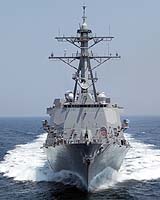
The U.S. and Japan tested a new Theatre Missile Defense (TMD) technology Wednesday off the coast of Hawaii. A missile was launched by an Aegis cruiser and successfully deployed a new Japanese-designed nose cone.
These developments indicate that U.S. and Japan's efforts to expand joint military operations in the Asian-Pacific region are moving ahead. The U.S. is now pressuring Japan to get rid of their constitutional prohibition against having an offensive military. Together, the U.S. and Japan are now preparing a major military escalation in the region that is like a dart pointed at the heart of China.
China today has 20 nuclear missiles capable of hitting the west coast of the U.S. The U.S. has over 7,500 nuclear weapons. The new TMD technologies under development by the U.S. and Japan are intended to make it possible for China's 20 nuclear missiles to be taken out during an attack. The idea is that the Aegis destroyer would be based in Japan, South Korea and Taiwan, thus giving the U.S. the ability to virtually surround China's coastal region. Add to that the new permanent military bases the U.S. is now building in Afghanistan, right on China's inland border. These bases would also be outfitted with ground-based TMD systems. Together, along with planned airborne and space-based systems, the U.S. plan is to be able to launch a preemptive first-strike attack on China and then take out China's retaliatory response by using the new TMD interceptors.
At the U.S. Space Command, during the past couple of years, they have been war gaming this first strike attack on China. Set in the year 2016, the U.S. launches the attack and then attempts to pick off China's anemic nuclear response.
These joint U.S. and Japanese TMD operations are helping to increase tensions in the region and are forcing China to make defensive military build-ups along their border regions.
It should be remembered that not long ago, Japan was the fascist imperial power in the region that invaded Manchuria, China and Korea that helped kick-off World War II. The Japanese were known to have killed large numbers of civilians during their brutal occupations of these countries. Japan blew up one of its own
trains in September of 1931, blaming it on China, and using it as a pretext to invade Manchuria. The incident was used to justify the invasion on the grounds that Japanese interests had to be protected from assaults by the Chinese. (Sound familiar?)
So the U.S. and Japan are now playing an old game. They are moving to militarize the region, as China defensively responds, the U.S. accuses China of trying to control the region. China gets surrounded, tensions rise and at some point the fuse gets lit. An explosion happens and China will get blamed. The U.S. and Japan do not intend to let China become a major power without first trying to control her. As the Washington Post said in 2001, the U.S. will now double our military presence in the Asian-Pacific region so that "we" can "manage" China.
No comments:
Post a Comment